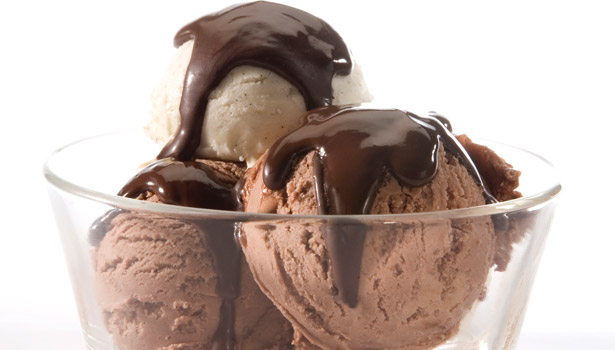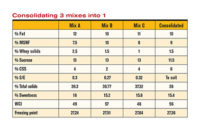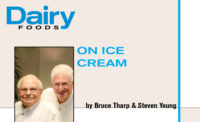Chocolate is second only to vanilla as the most popular ice cream flavor in the United States. Therefore, it is a major component of the product portfolios of most ice cream companies, representing on average of 8% to 10% of the volume of a typical portfolio.
In addition, over two-thirds of all ice cream products are vanilla, chocolate or vanilla/chocolate-based. Thus, proper formulation of any chocolate ice cream (and vanilla ice cream as well) to be sold as chocolate ice cream or as chocolate ice cream with inclusions becomes critical to portfolio market positioning, finished-product economics and desirable sensory appeal. The use of chocolate-based inclusions (which are critical to eating quality) is beyond the scope of the discussion here.
Chocolate refers to one of a variety of foods produced from fermented, roasted and ground seeds of one of several varieties of a tropical tree (Theobroma cacao). Because of variables related to the variety used and the nature of the cocoa processing, a broad range of chocolate products with respect to composition and flavor profile are available for use in ice cream. As a result, there is a comparably broad range of consumer preference for chocolate products, leading to deeply polarizing preferences within the chocolate ice cream category itself.
Chocolate ice cream is distinguished from other ice cream flavors by a variety of factors related to composition, flavor, body (chew/bite), texture (smoothness), color and how it is regulated. As a result, its production usually involves the preparation of a separate mix that differs in its composition from that of a typical “white” mix.
Understanding cocoa
Cocoa products used to flavor chocolate ice cream are usually used at a level in the range of 2% to 6%, but most frequently 2% to 4%. The most common include cocoa powders with fat levels of either 10% to 12% or 20% to 22%. Occasionally, chocolate liquor, with 50% fat, is used. Important variables include cocoa fat content; particle size; color; pH; solubility; bean source; and processing conditions. Proper selection of the type and level of any ingredient used to deliver chocolate flavor (and color) profile is critical.
With regard to particle size, large, coarsely ground cocoa particles can contribute an undesirable, slightly mealy, powdery texture and therefore should be avoided. The color of cocoa powder can vary from a light yellowish-brown through light brown, reddish brown, and dark brown to almost black. Color of the ice cream is also affected by the contribution of other mix ingredients, processing and the overrun of the finished ice cream.
The flavor of cocoa comes from the nonfat portion. Therefore, the flavor profile becomes more intense and in general, harsher as the cocoa fat decreases. Since cocoa fat contributes to rounding off harsh/bitter notes, the use of higher fat powders is desirable. However, their lesser flavor intensity requires higher use levels, resulting in a higher cost. The most common practice is to use cocoa with either 10% to 12% or 20% to 22% fat.
Diving into dark chocolate
Dark chocolate is a form of chocolate with a high level of cocoa solids that carries a strong bitter flavor note preferred by some chocolate consumers. It also contains high levels of flavanol compounds that have been associated with certain health benefits.
It is possible to leverage the perceived benefits of dark chocolate by producing a dark chocolate ice cream. Any relevant declarations related to dark chocolate ice cream should be discussed with the supplier and reconfirmed by a regulatory authority.
Research at Penn State University indicates that devotees of dark chocolate accept a lower level of sweetness in chocolate ice creams. Thus, the possibility exists of producing a niche chocolate ice cream with a lower sweetness level, which runs counter to conventional practice of increasing sweetness in chocolate ice creams.
Using lower levels of sweetener would have the effect of increasing freezing point, by as much as 0.5 F or more. We have reported elsewhere that increasing freezing point can have beneficial effects on textural shelf life by reducing the average size of ice crystals at the point of freezer exit. Increasing freezing point also restricts the growth of ice crystals during exposure of ice cream to high temperatures and the influence of heat shock.
To appeal to consumers who prefer a milder milk chocolate flavor profile, the harsh/bitter taste associated with chocolate can be mitigated to some extent by adding standard vanilla to the mix at the flavor tank, at a level approximately half that used in vanilla ice cream. The effect is dramatic and results in a more mellow-flavored chocolate ice cream.
Take chocolate with a grain of salt
A judicious amount of salt can be added (no more than 0.1% of total solids) to enhance chocolate flavor. Care must be taken to avoid over-use of salt in order to avoid pronounced/undesirable saltiness. It should also be recognized that salt has a profound freezing point depression effect. Even at a level of 0.1%, it can reduce freezing point by about 0.2 F. That reduces the amount of water frozen at a typical drawing temperature by as much as 6%, an effect that could slightly increase the size of ice crystals and reduce textural shelf life. However, the use of added vanilla and/or salt has a positive marketing effect by helping to easily differentiate chocolate products from one another.
An alternative approach to reducing the bitterness of chocolate ice cream involves the use of an alkalized, or Dutch process, cocoa. The “Dutching” process produces a cocoa with a milder flavor profile and often a lighter color.
Because of the harsh/bitter flavor profile typically contributed by commonly used types and amounts of cocoas, it is a common practice to minimize the perception of the bitter flavor note by increasing the equivalent sweetness of chocolate ice creams by 1% to 2% in comparison to that of other flavors. This practice could also produce negative influences of freezing point depression.
When considering the source of sweetness of any chocolate ice cream, the amount and type of sweetener and its compatibility with chocolate under conditions of consumption should be considered. This typically means a higher percent of total sweetness from sucrose (sugar) versus other alternatives.
Considerations also include influences on mix and finished ice cream functionality (flavor, color, eating quality, resistance to heat shock, etc.), sweetness, saltiness, freezing point and other attributes when whey solids of any type are applied up to the allowed maximum of 25% of total MSNF (milk solids not fat).
Since cocoa powders contribute a significant bulking effect due to fat and naturally occurring high molecular weight carbohydrates in the cocoa itself, it is usually the practice to use lower levels of MSNF and corn sweetener in order to avoid undesirably high total solids levels. Even so, the total solids level of chocolate ice cream is usually several percentage points higher than in most other products.
Complying with the Standard of Identity
The Standard of Identity for frozen desserts, including ice cream, contains a provision that has a direct effect on developing the composition of chocolate ice cream. That provision reduces minimum compositional requirements when bulky flavorings are used. In such products, the requirements for a minimum of 10% milk fat and 20% total milk solids (TMS) in full-fat ice cream apply only to the portion of the product other than the bulky flavoring material present. Allowance is also made for the fact that additional sweetening is needed for some bulky flavoring ingredients, including chocolate. For the purposes of applying this concept, the additional sweetener is considered to be part of the bulky flavoring system. In chocolate ice cream, the standard allows the level of cocoa to be increased by a factor of 2.5.
For example, in a chocolate ice cream containing 4% cocoa, the total bulky flavoring system is considered to be present at a level of 10% (4% x 2.5). The amount of the ice cream portion of the product becomes 90% (100% minus 10%). The minimum milk fat level in the total product thus is 90% (90% x 10% — the minimum fat level in full-fat ice cream).
Similarly, the minimum TMS level for this example is 18% (90% x 20% — the minimum TMS level in full-fat ice cream). Under the terms of this provision, the levels of milk fat and TMS can be no less than 8% and 16%, respectively.
Mix making
The production of a separate chocolate mix for use in chocolate ice cream and for other flavors based on chocolate is preferred. However, that practice may be limited by the unavailability of mix storage space or other logistical factors. In such cases, it is possible to convert a white mix to chocolate by adding chocolate syrup at the flavor tank. When this is done, additional sweetness can be provided via an appropriate level of sweetness in the syrup. It is required that anything added after pasteurization must have been rendered pathogen-free by an FDA-approved process.
This practice can offer manufacturing efficiencies while allowing a variety of chocolate-flavored executions without the need for additional mixes. However, the practice does fall short of producing the flavor profile associated with the thorough amalgamation of the various sources of chocolate flavor that is achieved by pasteurizing and homogenizing a separate chocolate mix.
Delivery of quality chocolate ice cream depends on understanding what can or cannot be done to meet or exceed consumer expectations. Over two-thirds of your product portfolio depends on it.
For further study
- Read more about formulating chocolate ice cream in “Tharp & Young on Ice Cream: An Encyclopedic Guide to Ice Cream Science and Technology” available at dairyfoods.com.
- To learn ice cream processing first-hand, attend the “Tharp & Young on Ice Cream, Technical Short Course, Workshops and Clinics,” Dec. 3 to 5 in Las Vegas.
- For more on domestic, international and custom on-site courses, book purchases and related discounts, go to www.onicecream.com or call 610-975-4424 or 281-782-4536.



